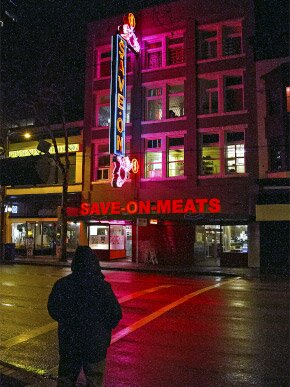Revitalization or Gentrification in Vancouvers Downtown

Description
This Visible City activity is based on the debates around the redevelopment of the Downtown Eastside neighbourhood of Vancouver. The photos and descriptions of two iconic neon signs in the Downtown Eastside of Vancouver, as well as original interviews with residents will introduce students to the neighbourhood and the importance of the places that the signs indicate. Students will do some basic research on the contemporary settings of these signs and the surrounding neighbourhood, play a game that will enact urban development, and discuss the advantages and disadvantages of developing the Downtown Eastside.
Learning Objectives
- Demonstrate effective research skills, including accessing and assessing visual and auditory information in order to form a critical opinion
- Learn about two significant institutions in the urban history of Vancouver
- Establish links between the identity of a neighbourhood and its economic development over time
- Speak and listen to extend thinking by contextualizing and explaining relationships between new ideas and information
- Understand and analyze the concept of gentrification
- Critically explore the positive and negative implications of the development of urban neighbourhoods like the Downtown Eastside
- Demonstrate written and oral communication skills by developing, assessing, and defending a variety of positions on controversial issues
Activity
1. Discussion Questions:
- What differences can you see between the 1907, 1938, and 2010 photos of the Woodward’s “W”?
- From the information provided, how can you tell that places like Woodward’s or Save-on-Meats were important to the everyday lives of local residents? For what reasons was it important for them? Give specific examples from the interviews you listened to or read.
2. Research: Use Google Earth or Google Maps technology and your own thoughtful opinions to answer the following questions.
- What is the Woodward’s building used for today?
- What does the neighbourhood to the West of Woodward’s look like now? What kinds of stores or other establishments surround Woodward’s?
- What does the neighbourhood to the East of Save-on-Meats look like today, and what surrounds it?
- Do you see any major differences in the organizations along Hastings street within four blocks of Woodwards and Save-on-Meats (along Hastings street, hemmed in by Main street to the East and Cambie street to the East)? What kinds of communities do you think these organizations serve?
- Remembering what local residents said about this area in the interviews, how would you characterize the changes in this neighbourhood based on the institutions and organizations you found within these four blocks?
- How do you think the changes in the neighbourhood, reflected by the changes in the Woodward’s and Save-on-Meats stores, affect local residents?
- Do you think the new “W” relates to the changes in the neighbourhood? Why do people like Mark Brand and Helen Hill say is it important that the Save On Meats sign has not changed?
3. Read:
A recent article from the local Vancouver magazine, The Dependent, discusses the rapidly changing situation in the Downtown Eastside and its implications: http://thedependent.ca/featured/gentrifiers/
In a group, answer the following questions:
- What is gentrification?
- Why is it problematic?
- What does the author mean by revitalization?
- How does revitalization relate to gentrification?
- Why is the line between revitalization and gentrification “blurry and awkward”?
- Why does the author say “the road to caramel machiatos is paved by artists and daring entrepreneurs”?
- What does it mean to make a neighbourhood “better”?
4. Play:
Students play the game of Monopoly, but with a few additional rules, to understand the processes and effects of developing a neighbourhood in the context of an unequal playing field.
The objective of the game is to become the wealthiest player by buying, selling, and renting property. Rather than starting everyone off equally as the regular rules suggest, in our game, two players will be given $50 start up money rather than the usual $200, and two players will be given $400. Two other players will only be able to throw the dice every second turn. These and every additional player will be given $200, as per the regular Monopoly rules. The players to whom these special rules apply will be randomly chosen through a roll of the dice to begin.
As the game progresses, some players are able to gain income and develop properties in particular areas, while others have to pay to pass through developed areas. If players cannot pay because they lack the money, they are banished from the area and even go to jail.
5. Classroom Brainstorm and/or Debate: Revitalization or Gentrification?
Based on your individual research, the article in The Dependent, and your experience playing Monopoly, what do you think are the advantages and disadvantages of developing the Downtown Eastside?
Learning Objects
Download all Learning Objects:
ZIP 126 MB: 3-les_objets_dapprentissage-learning_objects.zip
Download Lesson Plan (PDF):
PDF 606 KB: 3_plans_de_lecon-lesson_plans-Eng.pdf
Download Adobe Acrobat:
http://www.adobe.com/ca/products/reader.html

1_Woodwards_Beacon1938_CVA_Van_Sc_P114.tif (Photo name included for reference)

1_Woodwards_Exterior1907_VPL5248.tif (Photo name included for reference)

2_SaveOnMeats_Exterior_VancouverSun.tif (Photo name included for reference)

3_Woodwards_Installation2010_VancouverSun.tif (Photo name included for reference)

3_Woodwards_Workers2010_VancouverSun.tif (Photo name included for reference)

Save On Meats (4 of 7).tif (Photo name included for reference)

Save On Meats (6 of 7).tif (Photo name included for reference)
More Lesson Plans
For a full range of lesson plans from this virtual exhibit and others, please visit:
http://www.virtualmuseum.ca/edu



